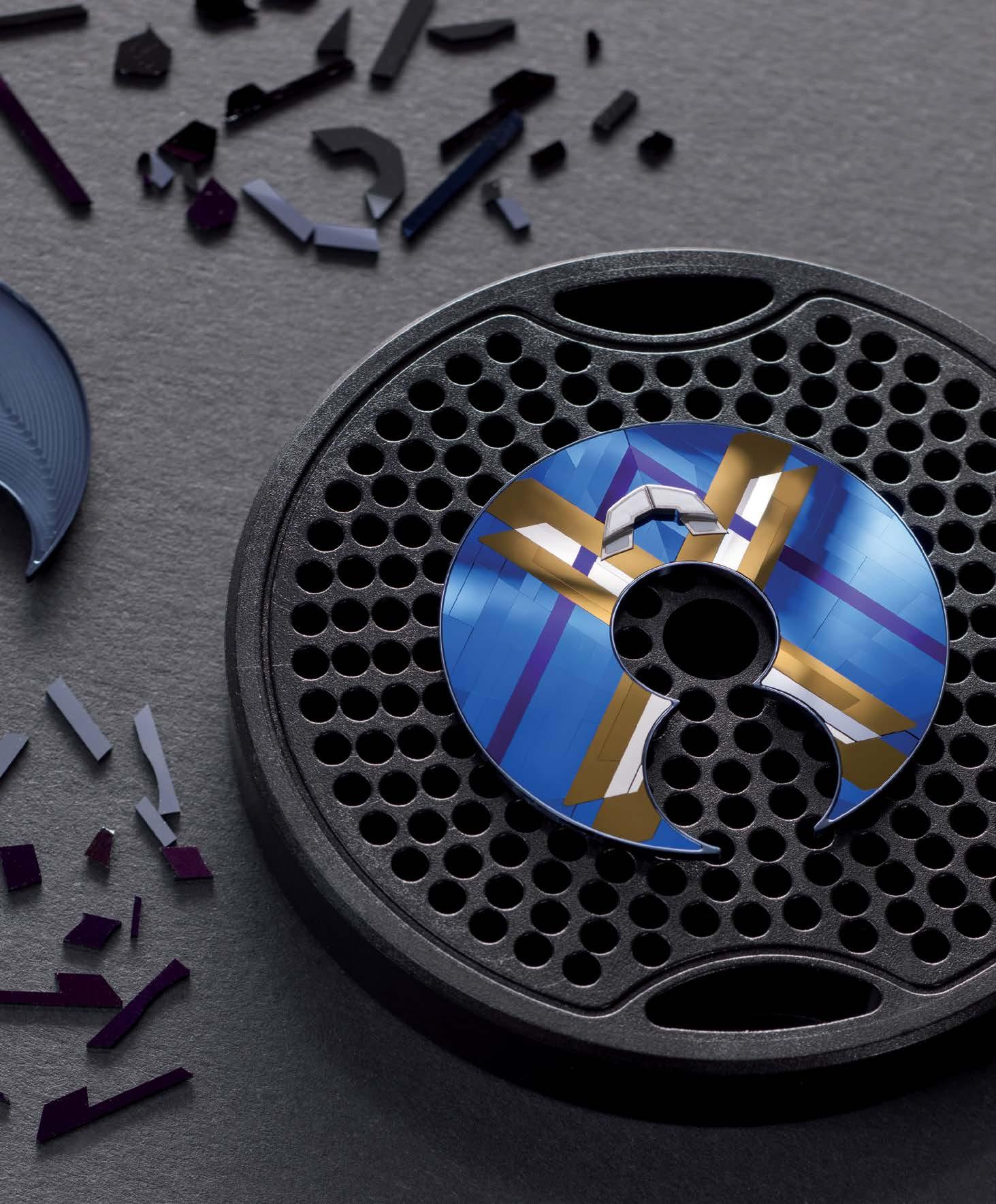
13 minute read
HAUTE MOVES

A silicium sensation
Ulysse Nardin takes the use of a traditional technique to a new level with its Freak X marquetry.
BY MARTIN GREEN
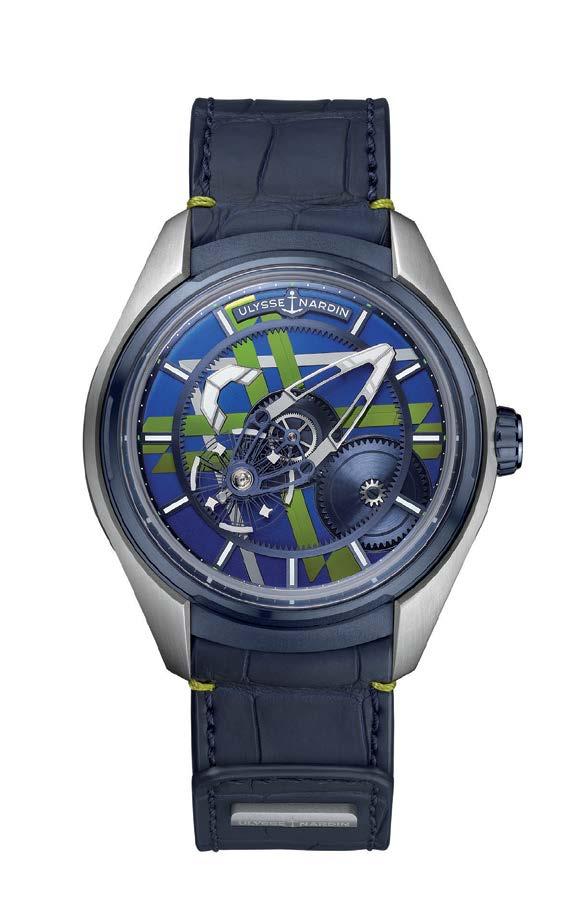
HOT ON THE HEELS OF THE FREAK X RAZZLE DAZZLE LAUNCH, Ulysse Nardin continues to impress as it introduces the Freak X Marquetry. This traditional and very demanding technique is usually executed in natural materials such as wood, straw and feathers. However, if there is one material that has had a profound impact on the (recent) history of Ulysse Nardin, it is silicium. The brand started using it as early as 2001, and it has proven to be one of the trailblazers in the industry, bringing this technology and these watches to the next level. It now does the same with the art of marquetry as it launches the world’s very first silicium marquetry watch.
The canvas for this artistic expression is the Freak X, a watch that has quickly become one of the most popular and successful Ulysse Nardin watches. Creating a silicium marquetry dial is a combination of high-tech and traditional skill. The silicium is cut into different-size segments with the help of a plasma generator. After that, it takes a significant amount of skill and a steady hand to move the silicium parts to the dial and affix them. The silicium has a tendency to chip at even the lightest impact when in small pieces, which makes placing them on the dial a challenge only a few are up to.
The result is breathtaking and unique in the watch world. The silicium marquetry dial shows an extraordinary play of light, resembling that of a laser beam. Ulysse Nardin has even been able to create the silicium in two colors, blue and green, giving the first a matte finish for even more contrast. This is not the only silicium visible, as this Freak X is powered by caliber UN-230, a carrousel movement with its high-tech balance wheel made of silicium visible at the front. With the new Freak X Marquetry, Ulysse Nardin is bringing the past into the future, presenting itself once again as the undisputed master of silicium.


PHOTO COURTESY OF LAMBORGHINI AUTOMOBILI
MOVESHaute AUTO + YACHT
2022 Huracán Super Trofeo EVO2
Lamborghini Squadra Corse has launched a new variant of the model seven years after its debut that will be used across all three continental Lamborghini series.
BY NIKITA VIVEK PAWAR


LAMBORGHINI IS SYNONYMOUS WITH CHAMPIONSHIPS. The marque’s EVO2, just like other Lamborghini Super Trofeos, is based on the Huracán model, and this newer version is a bold and vigorous racing car. Radical aerodynamic refinements and uncompromising design make the Huracán Super Trofeo EVO2 the most high-performance version of the most stunning vehicle. “The Huracán is one of the biggest bestsellers in the history of the brand, and the Super Trofeo has additionally helped to increase its success,” says Stephan Winkelmann, president and CEO of Automobili Lamborghini.
From an aesthetic point of view, the car takes the design of the previous generations to the extreme. Significant changes include new high-intensity, full LED light clusters with a hexagonal structure and a pronounced “omega” lip that joins the carbon fiber fins and reinforces the stylistic link with the Huracán STO. New air curtain intakes optimize airflow by keeping it adherent to the sides and downforce, improving the vehicle’s aerodynamics. The rear is dominated by the large carbon fiber wing, which was inspired by minimalism and lightness. The arched bumper harmoniously links the aerodynamic appendages located behind the wheels to the redesigned diffuser fins. In addition, the rear fenders are now composed of a single element, which includes part of the side spoiler, for optimal surface continuity. The braking system, designed and developed by Squadra Corse, features 15.35-inch rotors up front and new callipers, covering more surface area and providing better stopping power than before. The steel front discs are increased from 380 to 390 mm; the new callipers can accommodate pads with a unique design and a larger surface area to optimize performance and consumption.
“When we approached the Huracán Super Trofeo EVO2 project, we immediately thought of the concept of ‘Racing in style.’ That is, a combination of the typical aggressiveness of the Huracán racing cars and the classic stylistic features of Lamborghini’s DNA,” says Lamborghini head of design Mitja Borkert. “In addition, the Huracán Super Trofeo EVO2 represents a futuristic aesthetic approach that partially anticipates the design elements of the next range of road cars.”
The car is propelled by a 5.2-liter naturally aspirated V10 engine. Coupled with the sequential six-speed X-Trac gearbox combined with rear-wheel drive, it delivers a maximum power output of 620 HP, thanks to the new aero package.
“The Super Trofeo is the basis of our concept of customer racing, capable of involving and exciting both young talents and gentleman drivers,” says Giorgio Sanna, the company’s head of motorsport. “It is dedicated to both categories of drivers, and we have designed it with the precise aim of offering an even more engaging driving experience while paying the utmost attention to running costs.”
The Huracán Super Trofeo EVO2 made its public debut on May 28 in Le Castellet, at the second round of the Lamborghini Super Trofeo Europe. The price for the European market is €250,000, excluding taxes.

Finally in the Wild
The French luxury automaker has at last revealed a bespoke project that took over two years to complete: the Bugatti La Voiture Noire.
BY NIKITA VIVEK PAWAR


IT WAS AT THE 2019 GENEVA MOTOR SHOW THAT BUGATTI REVEALED the plans for its La Voiture Noire concept car. Two years later, the project has finally launched, and it’s stunning.
The name “La Voiture Noire” has a particular ring in the automotive world: Ettore Bugatti’s son Jean developed and drove one of just four Type 57 SC Atlantics produced, the most perfect and the fastest automobile of its time. He named his model “La Voiture Noire” – the black car. But in one of the greatest mysteries of the automotive world, the Type 57 SC Atlantic disappeared without a trace shortly before World War II. If it was found today, it would be one of the world’s most valued vehicles.
The idea for this homage came to design director Achim Anscheidt more than 20 years ago, but decades passed until it became possible to realize the unusual project. “We were rather in awe of the idea of developing the La Voiture Noire,” Anscheidt says. “No other vehicle in the long history of Bugatti has acquired the same legendary status as the Type 57 SC Atlantic and has become so synonymous with the brand. We had a great deal of respect for this historical responsibility, as well as for the customer.”
The La Voiture Noire is at the cutting edge of automotive engineering. Bugatti developed the unique coupe as elaborately as its other hyper sports cars in just two years. Every new part had to pass strict testing, and quality procedures were measured and were put through their paces before finding their place in the vehicle. The one-of-a-kind has already been sold to a Bugatti enthusiast for 11 million euros (roughly $13 million before tax).
The car is a minimalist coupe much like the Atlantic was. With reduced lines and absence of a large and dominant rear wing, the designers reinterpreted the spirit of the historical vehicle and developed a specific shape, stylistically and technically speaking. With great attention to detail, they created a body with a unique surface finish – a visible carbon fiber with a clear coat known as Black Carbon Glossy. “With its use of visible carbon fiber in jet black, the coupe’s breathtaking sculpture looks especially elegant,” says Bugatti president Stephan Winkelmann. “It’s a veritable grand tourer that went from being a vision to a reality – a unique project that stands for Bugatti’s full creativity and artistry.” The carbon fiber generates virtually no reflections but plenty of tension and drama. The bumpers are integrated gently into the bodywork, while the windscreen appears to merge with the side windows like a helmet visor.
There are more than 25 individually milled light elements per side in the headlamps, an immense amount of work, even for a one-off. The 3D-printed front grille has been honed to ensure that they all look perfect together. The rear is dominated by an elegant rear light, which for the first time features a single-piece surround with no joints with six individual tailpipes to honor the vehicle’s well-known template.
For the interiors, grain leather in Havana Brown, based on the historical model, covers the vast majority. The center console is specially polished, and turned aluminium inlays contrast with the natural material. A sophisticated rosewood switch controls the driving modes.

SPORTY ICON SPORTY ICON
Wally shows its sporty side with the 43wallytender X, a new outboard version of the 43wallytender with enhanced speed, premium features and style.
BY NIKITA VIVEK PAWAR
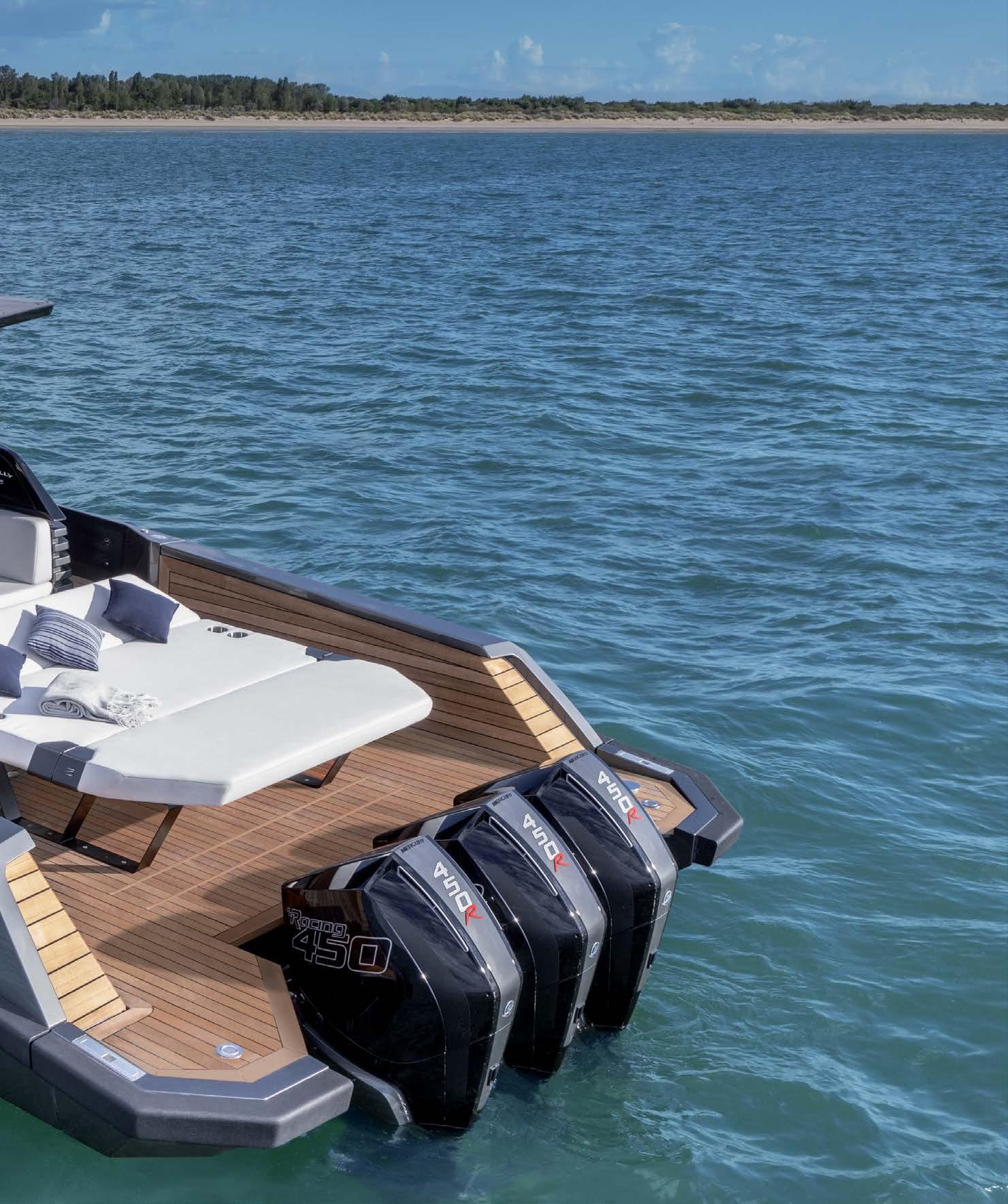
AFTER THE LAUNCH OF THE 43WALLYTENDER LAST NOVEMBER, Wally was applauded for its impeccable design philosophy and expertise. The shipyard has taken its game to the next level with the launch of the 43wallytender X, which offers even more speed.
The debut design featured Wally’s innovative center cockpit design, which offers the protection of a cockpit alongside the practicality and access of a walkaround and modular deck configuration that can adapt to an owner’s needs. Its successor features a protected cockpit with a wraparound glass windshield. The design combines the feeling of freedom in the open air and the security and comfort of a more enclosed yacht. Developed by Wally and Ferretti Group’s engineering department, the boat is constructed in advanced composites with carbon fiber at the Wally facilities in Forlì, with a 21-degree, deep-V deadrise that delivers exceptional seaworthiness. The tender is the first unit being finished in Wally’s exclusive dark grey hue.
“The highlight of the Wallytenders is their ability to serve a variety of purposes through their pure, simple and seaworthy design. The inboard 43wallytender was very well received last year, and we feel there is a segment of the market that will benefit from the same design elements but with the performance of an outboard propulsion system,” says Stefano de Vivo, Wally managing director. “It could be a large yacht looking for the master of versatility to add to its tenders fleet, a family in search of the ideal day boat to take them to the sandbar, or an adventurous owner with water sports passion. The design is also well suited for a hotel shuttle, a day charter boat or a scuba platform.”
The 43wallytender X comes with a standard propulsion package that has a triple 300hp Mercury Verados engine with a top speed of 40 knots. Seafarers can also consider an additional 10 knots with triple 450R Mercury Verados, and can opt for the battery pack running the Seakeeper stabilizer powered by solar panels mounted on the T-top. The boat features a protected a cabin with bathroom and separate shower, expansive side-opening bulwarks, a protective T-top and a teak deck as standard.
Billed as “the ultimate day boat,” the 43wallytender X offers a modular aft deck configuration to suit various purposes. Patrons can also choose the large sun pad to provide easy-access storage for water toys under the comfortable lounging space. The yacht can be equipped as a water sports boat with a ski pole and other accessories for the ideal on-water experience. The pillarless windshield is made from tempered glass, the largest in its class. A large cooler box has been integrated into the seating to offer ultimate comfort. Below deck, the climate-controlled cabin provides an ideal setting for relaxation and siestas away from the heat of the afternoon. The cabin is equipped with a separate shower compartment that has generous headroom.
Wally has designed its T-top dimensions to fit under coastal bridges such as those in the Miami area, meaning no more waiting around for waterways to open. Its shallow draft allows owners to cruise wherever they desire, whether closer to the shoreline, right into keys or to spots that other boats cannot access.
The 43wallytender X made its world debut at the Venice Boat Show.
Sustainable Superyacht
The NL 285 Vento project is a manifesto for environmental protection and appeals to designers and owners to develop authentically green large yachts.
BY NIKITA VIVEK PAWAR
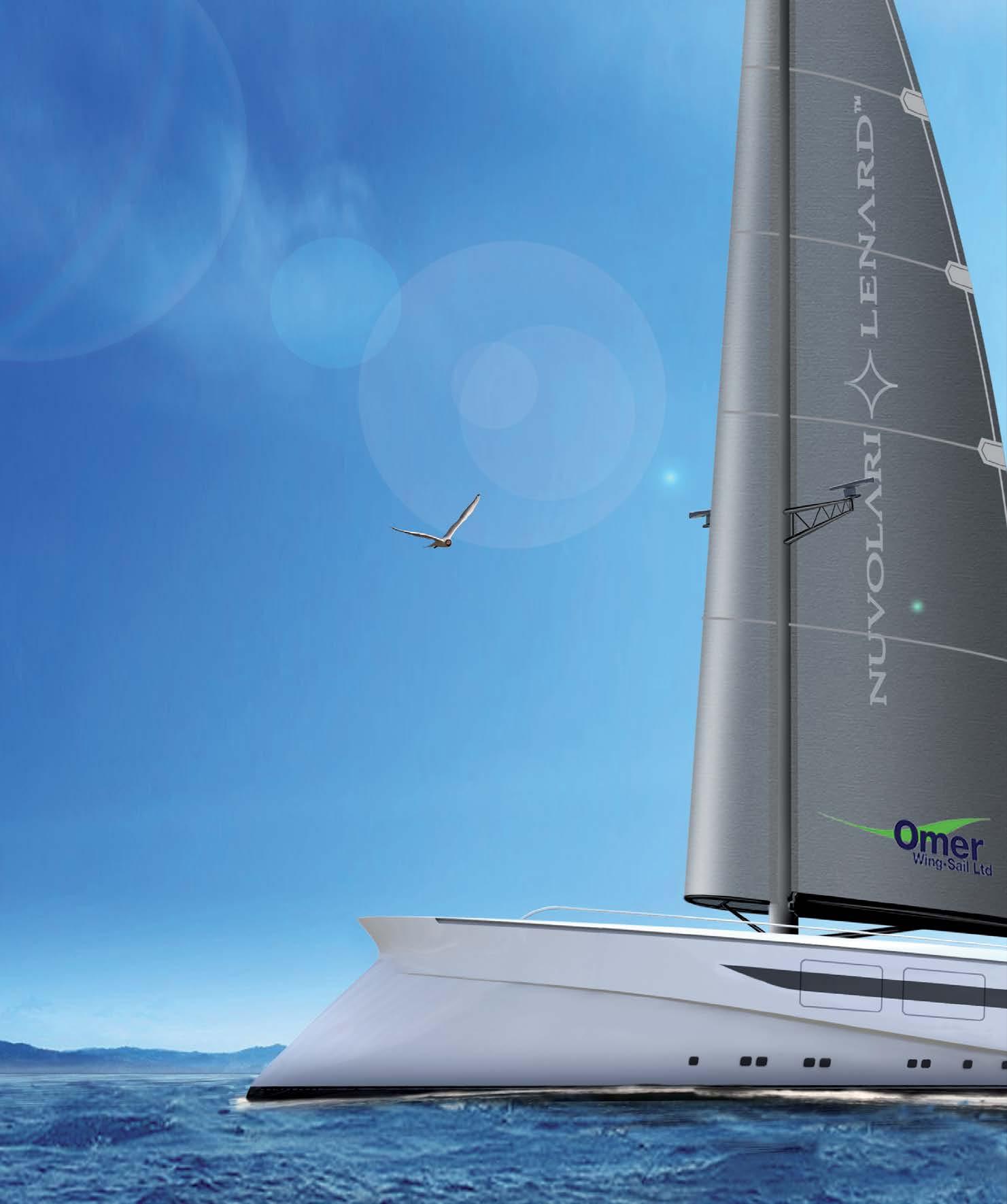
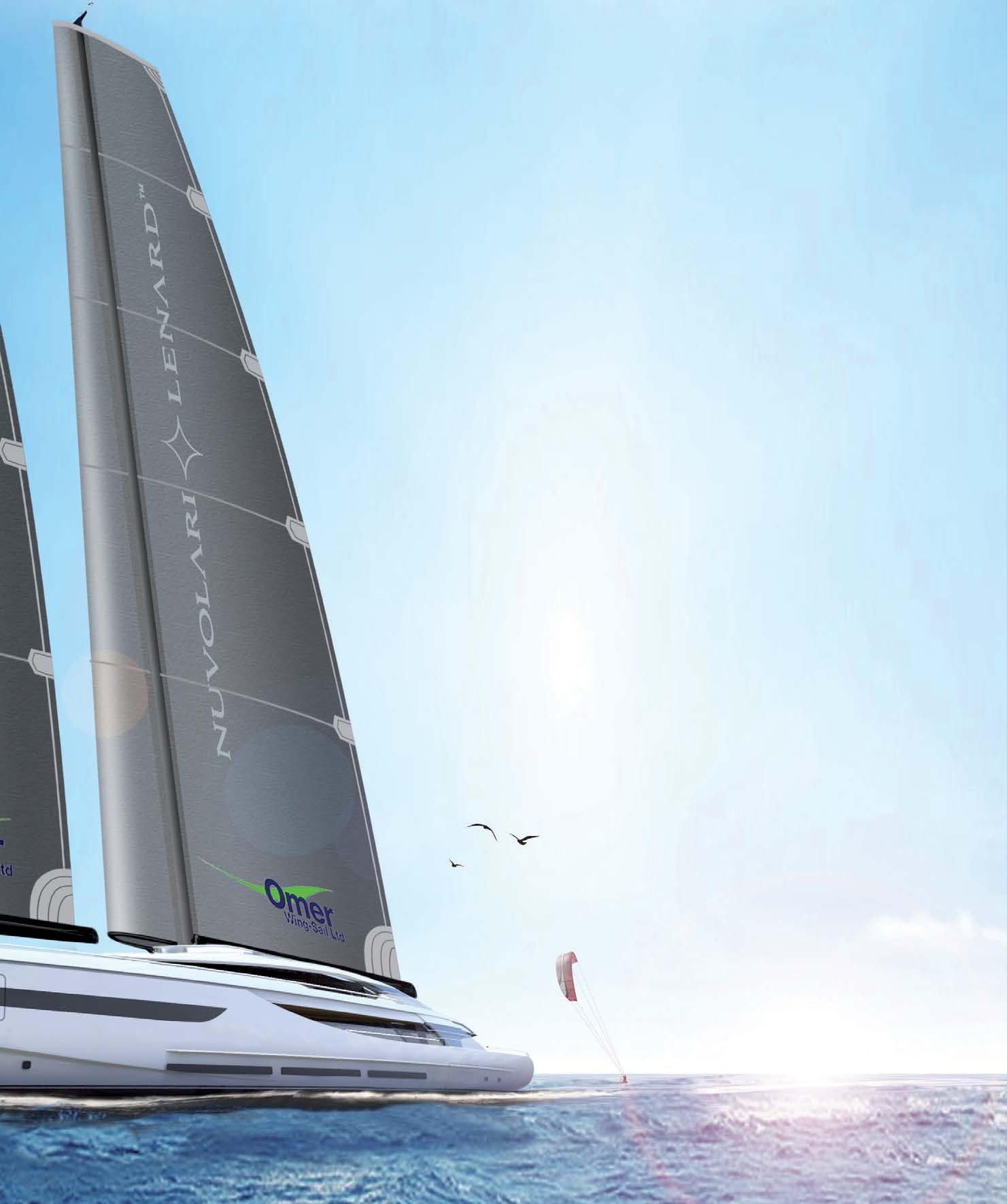
A SUPERYACHT GENERALLY CONSUMES ABOUT 32 MILLION gallons of oil and produces 627 million pounds of carbon dioxide emissions a year. However, in recent years, there has been a cumulative effort to minimize the environmental imbalance. At the Venice Boat Show this year, Italian ship designers Nuvolari Lenard revealed the NL 285 Vento, a 100-meter sailing superyacht that is ecosustainable and naturally environmentally friendly.
Carlo Nuvolari and Dan Lenard, founders of the Venetian design studio, strongly believe in sustainable yachting. The Vento isn’t their first sustainable yacht. Their latest projects include Thunder, the 14-seater hybrid Venetian water taxi launched in 2020. The designers have also been part of successful projects for iconic shipyards such as Oceanco, Palmer Johnson, Perini Navi and CRN Ferretti.
Nuvolari Lenard decided to take a different approach to the Vento that would also account for sustainability.
The Vento is not the umpteenth “sail assisted megayacht” but an authentic and exquisite sailing vessel that will use wind as its natural propulsive force.
“Being environmentally conscious has to become a way of being, as well as a way of thinking,” explains engineer Nuvolari. “There’s nothing stopping us from thinking about a truly green large yacht. It’s not difficult to achieve major results; you just have to stop being traditionalist and take a risk, going back to the basics: building a sailing yacht that really uses sails and is really efficient.”
Like every Nuvolari Lenard project, the Vento has spacious and well distributed interiors within sporty and powerful lines, thanks to a careful study of volume and flow. Its robust, aggressive profile confirms its unique character. The reverse bow gives the yacht a strong personality while allowing the waterline length to be extended to the maximum, thus increasing stability and performance when sailing. The result is a hull with reduced drag and lower power requirements for a given speed. The sloping stern also fulfils a function, because, with its small volume, it will have less impact on the overall displacement, which is crucial to an efficient and sustainable hull.
An efficient hull must be matched by an appropriate sail plan that maximizes its benefits and performance. So Nuvolari Lenard turned to Omer Wing-Sail and its creator, Ilan Gonen, an former Israeli fighter pilot, aerodynamics expert and keen sailor. The result is a unique wing sail, which, as demonstrated by recent America’s Cup hulls, offers significantly greater efficiency than traditional rigs. As far as engine propulsion is concerned, a hybrid diesel/electric system with variablespeed generators and variable pitch achieves maximum efficiency and minimum specific consumption.
The concept features six spacious double cabins: four VIP, one super VIP and the large master suite forward of the main deck, with a private terrace. The outdoor spaces are also vast and varied, including a flybridge, spa, beach club and all the other extras you’d expect on a megayacht of this size.
An electric motor and batteries are not enough to make a boat green; we need to change our mentality to acquire a global vision that can balance the benefits and costs of certain choices and project them into the future. A new way of thinking about sailing megayachts, with a real focus on ecology, is possible: Vento is a testament to this.








